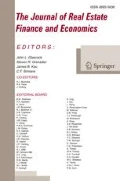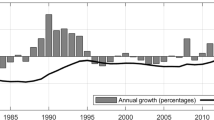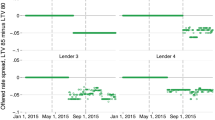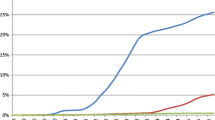Abstract
Using a sample of 26,892 rate quotes on home purchase loan applications, the current paper investigates interstate variation in residential mortgage interest rates. More specifically, we find posted rate quotes by lenders are directly related to measures of foreclosure process risk including the length of time required to complete foreclosure proceedings within a jurisdiction and the presence (and length) of statutory redemption periods. Mortgage rates are also found to be contingent upon differential underwriting fees and conditions, housing appreciation and volatility measures, and the competitive nature of the economic marketplace in which each lender operates. In contrast to the previous literature, we find the judicial foreclosure process requirements exert little to no impact on observable mortgage interest rate quotes after controlling for these additional dimensions of risk.
Similar content being viewed by others
Notes
See, for example, Stiglitz and Weiss (1981) for a theoretical discussion of credit rationing versus risk-based pricing.
For a comprehensive survey of the early work in this area, see Quercia and Stegman (1992). Additional studies of note in this area include, but are not limited to: Von Furstenberg (1969), Campbell and Dietrich (1983), Hendershottt and Van Order (1987), Schwartz and Torous (1989, 1992), Berkovec et al. (1994), Munnell et al. (1996), Deng (1997), Avery et al. (2000), and Deng et al. (2000).
See Nichols et al. (2005) for an examination of the user costs of home ownership.
See, for example, Blackwell and Winters (2000).
Alternatively, large regional or national banks may possess reputational capital advantages which allow them to charge higher rates than their lesser known competitors. See Carter and Manaster (1990) for an extended discussion of the importance of reputational capital effects in security markets.
Within the current sample, only 712 of 26,892 rate quote observations (or 2.65 %) occur at intervals other than 1/8th of a percentage point.
More precisely, the rate quotes obtained for this sample were originally posted between April 8 and April 22, 2011, with each quote being an individual lender’s most recent listing for a specific city as of April 22, 2011.
While these effective rates serve as the dependent variable throughout the empirical analysis which follows, our results are robust to the use of the actual posted rate quote, the lender reported annual percentage rate (APR), or this implied effective rate computed using an assumed 7 year mortgage life.
We recognize this is a potential over simplification of idiosyncratic foreclosure practices employed across states. For example, many states allow both power of sale and judicial processes, with lenders frequently entitled to seek more immediate recourse via selecting power of sale procedures at the potential cost of limiting their ability to pursue large deficiencies which may only be obtainable through more formalized proceedings.
These jurisdictions include Boise, ID; Carson City, NV; Conway, SC; Lake Tahoe, CA; Lakeland, FL; Myrtle Beach, SC; Wilmington, NC; Winter Haven, FL; and Yuma, AZ.
Similarly, lenders may simply charge higher rates in such high cost areas to offset their normal cost of doing business associated with non-strategic default occurrences.
Subprime market share data estimates by state obtained from: http://money.cnn.com/magazines/fortune/storysupplement/subprime_statebystate/; accessed 9/9/2010.
The nine states without (ordinary wage and salary) income tax requirements for 2011 were Alaska, Florida, New Hampshire, Nevada, South Dakota, Tennessee, Texas, Washington, and Wyoming. The highest marginal rates were found in Oregon (9.0 %), Iowa (8.98 %), Maine (8.5 %), Washington D.C. (8.5 %), and California (8.0 %). For extensive discussion and details on individual state level tax rates and provisions, see: http://www.taxfoundation.org/; accessed 12/19/2012.
Throughout the empirical analyses which follow, we note that Bankrate quotes (i.e., our sample observations) are drawn from the automated underwriting systems of various lenders. To the extent lenders providing mortgage rate quotations across alternative geographic locations employ a single automated platform, our observations may not be independent. As a result, the statistical significance of our findings could be artificially inflated. Recognizing this concern, we make a concerted effort throughout the discussion of our analyses to emphasize the economic, as well as statistical, import of our findings.
While our redemption period length variable is statistically significant, the economic magnitude of this association is very small, rendering it essentially inconsequential as a material determinant of posted mortgage rate quotes. Alternative model specifications using a simple binary indicator variable identifying the presence or absence of any statutory redemption period provide similar results to those reported, with our indicator variable for the presence of a redemption period exhibiting statistical, but not economic, significance.
In estimating acceptance rates, we ignore LAR records corresponding to loan purchases and preapprovals, as well as information pertaining to loan applications which were withdrawn by the prospective borrower or closed by the institution without a formal credit extension decision being reached. Under this framework, over 80 % of mortgage loan applications were accepted and resulted in the extension of credit.
The authors attribute this latter result to the existence of either regulatory capital arbitrage, or reputation building, on the part of lending institutions.
From September 7, 1996 until October 1, 2013, Freddie Mac required a delivery fee on mortgages secured by condominium units in California. However, this fee was in response to perceived earthquake risk and uncertainty surrounding the efficacy of earthquake insurance requirements. Foreclosure process risk was not a material consideration in the adoption of this fee.
Given that judicial foreclosure jurisdictions are associated with longer disposition times, this is consistent with the strategic default motivation of being able to live in the home “mortgage payment free” for an extended period.
References
Allen, M., & Dare, W. (2004a). The effects of charm listing prices on house transaction prices. Real Estate Economics, 32(4), 695–713.
Allen, M., & Dare, W. (2004b). Charm pricing as a signal of listing price precision. Journal of Housing Research, 15(2), 113–127.
Ambrose, B., & Pennington-Cross, A. (2000). Local economic risk factors and the primary and secondary mortgage markets. Regional Science and Urban Economics, 30(6), 683–701.
Ambrose, B., & Sanders, A. (2005). Legal restrictions in personal loan markets. Journal of Real Estate Finance and Economics, 30(2), 133–151.
Ambrose, B., Pennington-Cross, A., & Yezer, A. (2002). Credit rationing in the U.S. mortgage market: evidence from variation in FHA market shares. Journal of Urban Economics, 51(2), 272–294.
Ambrose, B., LaCour-Little, M., & Sanders, A. (2005). Does regulatory capital arbitrage, reputation, or asymmetric information drive securitization? Journal of Financial Services Research, 28(1–3), 113–133.
Archer, W., Elmer, P., Harrison, D., & Ling, D. (2002). Determinants of multifamily mortgage default. Real Estate Economics, 30(3), 445–473.
Avery, R., Bostic, R., Calem, P., & Canner, G. (2000). Credit scoring: statistical issues and evidence from credit-bureau files. Real Estate Economics, 28(3), 523–547.
Berkovec, J., Canner, G., Gabriel, S., & Hannan, T. (1994). Race, redlining, and residential mortgage loan performance. Journal of Real Estate Finance and Economics, 9(3), 263–294.
Billett, M., Flannery, M., & Garfinkel, J. (1995). The effect of lender identity on a borrowing firm’s equity return. Journal of Finance, 50(2), 699–718.
Bizer, G., & Schindler, R. (2005). Direct evidence of ending-digit drop-off in price information processing. Psychology and Marketing, 22(10), 771–783.
Blackwell, D., & Winters, D. (1997). Banking relationships and the effect of monitoring on loan pricing. Journal of Financial Research, 20(2), 275–289.
Blackwell, D., & Winters, D. (2000). Local lending markets: what a small business owner/manager needs to know. Quarterly Journal of Business and Economics, 39(2), 62–79.
Brenner, G., & Brenner, R. (1982). Memory and markets, or why are you paying $2.00 for a widget? Journal of Business, 55(1), 147–158.
Bridewell, D. (1938). The effects of defective mortgage laws on home financing. Law and Contemporary Problems, 5(4), 545–563.
Calem, P. (1996). Mortgage credit availability in low- and moderate-income minority neighborhoods: are information externalities critical? Journal of Real Estate Finance and Economics, 13(1), 71–89.
Campbell, T., & Dietrich, K. (1983). The determinants of default on insured conventional residential mortgage loans. Journal of Finance, 38(5), 1569–1581.
Carter, R., & Manaster, S. (1990). Initial public offerings and underwriter reputation. Journal of Finance, 45(4), 1045–1067.
Chomsisengphet, S., & Pennington-Cross, A. (2006). The evolution of the subprime mortgage market. Federal Reserve Bank of St. Louis Review, 88(1), 31–56.
Christie, W., & Schultz, P. (1994). Why do NASDAQ market makers avoid odd-eighth quotes? Journal of Finance, 49(5), 1813–1840.
Christie, W., Harris, J., & Schultz, P. (1994). Why did NASDAQ market makers stop avoiding odd-eighth quotes? Journal of Finance, 49(5), 1841–1860.
Clauretie, T. (1987). The impact of interstate foreclosure cost differences and the value of mortgages on default rates. Real Estate Economics, 15(3), 152–167.
Clauretie, T. (1989). State foreclosure laws, risk shifting, and the private mortgage insurance industry. Journal of Risk and Insurance, 56(3), 544–554.
Clauretie, T., & Herzog, T. (1990). The effect of state foreclosure laws on loan losses: evidence from the mortgage insurance industry. Journal of Money, Credit and Banking, 22(2), 221–233.
Clauretie, T., & Jameson, M. (1990). Interest rates and the foreclosure process: an agency problem in FHA mortgage insurance. Journal of Risk and Insurance, 57(4), 701–711.
Deng, Y. (1997). Mortgage termination: an empirical hazard model with stochastic term structure. Journal of Real Estate Finance and Economics, 14(3), 309–331.
Deng, Y., Quigley, J., & Van Order, R. (2000). Mortgage terminations, heterogeneity and the exercise of mortgage options. Econometrica, 68(2), 275–307.
Desai, C., Elliehausen, G., & Steinbuks, J. (2014). Effects of bankruptcy exemptions and foreclosure laws on mortgage default and foreclosure rates. Journal of Real Estate Finance and Economics, Forthcoming.
Diamond, D. (1989). Reputation acquisition in debt markets. Journal of Political Economy, 97(4), 828–862.
Fama, E. (1985). What’s different about banks? Journal of Monetary Economics, 15(1), 29–39.
Follain, J., & Dunsky, R. (1997). The demand for mortgage debt and the income tax. Journal of Housing Research, 8(2), 155–199.
Ghent, A., & Kudlyak, M. (2011). Recourse and residential mortgage default: evidence from US states. Review of Financial Studies, 24(9), 3139–3186.
Guiso, L., Sapienza, P., & Zingales, L. (2013). The determinants of attitudes towards strategic default on mortgages. Journal of Finance, 68(4), 1473–1515.
Harrison, D. (2001). The importance of lender heterogeneity in mortgage lending. Journal of Urban Economics, 49(2), 285–309.
Harrison, D., Noordewier, T., & Yavas, A. (2004). Do riskier borrowers borrow more? Real Estate Economics, 32(3), 385–411.
Hendershottt, P., & Van Order, R. (1987). Pricing mortgages: an interpretation of the models and results. Journal of Financial Services Research, 1(1), 19–55.
Kane, E., & Malkiel, B. (1965). Bank portfolio allocation, deposit variability, and the availability doctrine. Quarterly Journal of Economics, 79(1), 113–134.
LaCour-Little, M., & Malpezzi, S. (2003). Appraisal quality and residential mortgage default: evidence from Alaska. Journal of Real Estate Finance and Economics, 27(2), 211–233.
Lambert, Z. (1975). Perceived prices as related to odd and even price endings. Journal of Retailing, 51(3), 13–22. & 78.
Lang, W., & Nakamura, L. (1990). The dynamics of credit markets in a model with learning. Journal of Monetary Economics, 26(2), 305–318.
Lang, W., & Nakamura, L. (1993). A model of redlining. Journal of Urban Economics, 33(2), 223–234.
Ling, D., & McGill, G. (1998). Evidence on the demand for mortgage debt by owner-occupants. Journal of Urban Economics, 44(3), 391–414.
Ling, D., & Wachter, S. (1998). Information externalities and home mortgage underwriting. Journal of Urban Economics, 44(3), 317–332.
Lummer, S., & McConnell, J. (1989). Further evidence on the bank lending process and the capital-market response to bank loan agreements. Journal of Financial Economics, 25(1), 99–122.
Marschoun, M. (2000). Availability of mortgage loans in volatile real estate markets. Journal of Urban Economics, 47(3), 443–469.
Meador, M. (1982). The effect of mortgage laws on home mortgage rates. Journal of Economics and Business, 34(2), 143–148.
Munnell, A., Tootell, G., Browne, L., & McEneaney, J. (1996). Mortgage lending in Boston: interpreting HMDA data. American Economic Review, 86(1), 25–53.
Nichols, J., Pennington-Cross, A., & Yezer, A. (2005). Borrower self-selection, underwriting costs, and subprime mortgage credit supply. Journal of Real Estate Finance and Economics, 30(2), 197–219.
Noordewier, T., Harrison, D., & Ramagopal, K. (2001). Semivariance of property value estimates as a determinant of default risk. Real Estate Economics, 29(1), 127–159.
Palmon, O., Smith, B., & Sopranzetti, B. (2004). Clustering in real estate prices: determinants and consequences. Journal of Real Estate Research, 26(2), 115–136.
Pence, K. (2003). Foreclosing on opportunity: state laws and mortgage credit. Federal Reserve Board, Finance and Economics Discussion Series #2003–16.
Pence, K. (2006). Foreclosing on opportunity: state laws and mortgage credit. Review of Economics and Statistics, 88(1), 177–182.
Pennington-Cross, A. (2006). The value of foreclosed property. Journal of Real Estate Research, 28(2), 193–214.
Pennington-Cross, A. (2010). The duration of foreclosures in the subprime mortgage market: a competing risks model with mixing. Journal of Real Estate Finance and Economics, 40(2), 109–129.
Petersen, M., & Rajan, R. (1994). The benefits of lending relationships: evidence from small business data. Journal of Finance, 49(1), 3–37.
Posey, L., & Yavas, A. (2001). Adjustable and fixed rate mortgages as a screening mechanism for default risk. Journal of Urban Economics, 49(1), 54–79.
Quercia, R., & Stegman, M. (1992). Residential mortgage default: a review of the literature. Journal of Housing Research, 3(2), 341–379.
Salter, S., Johnson, K., & Spurlin, P. (2007). Off-dollar pricing, residential property prices, and marketing time. Journal of Housing Research, 16(1), 33–46.
Schaaf, A. (1966). Regional differences in mortgage financing costs. Journal of Finance, 21(1), 85–94.
Schindler, R., & Kirby, P. (1997). Patterns of rightmost digits used in advertised prices: implications for nine-ending effects. Journal of Consumer Research, 24(2), 192–201.
Schwartz, E., & Torous, W. (1989). Prepayment and the valuation of mortgage-backed securities. Journal of Finance, 44(2), 375–392.
Schwartz, E., & Torous, W. (1992). Prepayment, default, and the valuation of mortgage pass-through securities. Journal of Business, 65(2), 221–239.
Seiler, M., Seiler, V., Lane, M., & Harrison, D. (2012). Fear, shame, and guilt: economic and behavioral motivations for strategic default. Real Estate Economics, 40(S1), 199–233.
Stiglitz, J., & Weiss, A. (1981). Credit rationing in markets with imperfect information. American Economic Review, 71(3), 393–410.
Twedt, D. (1965). Does the ‘9 fixation’ in retail pricing really promote sales? Journal of Marketing, 29(4), 54–55.
Von Furstenberg, G. (1969). Default risk on FHA-insured home mortgages as a function of the terms of financing: a quantitative analysis. Journal of Finance, 24(3), 459–477.
White, B. (2010a). Take this house and shove it: the emotional drivers of strategic default. Arizona Legal Studies, Discussion Paper No. 10–17.
White, B. (2010b). Underwater and not walking away: shame, fear and the social management of the housing crisis. Wake Forest Law Review, 45, 971–1023.
Author information
Authors and Affiliations
Corresponding author
Rights and permissions
About this article
Cite this article
Harrison, D.M., Seiler, M.J. The Paradox of Judicial Foreclosure: Collateral Value Uncertainty and Mortgage Rates. J Real Estate Finan Econ 50, 377–411 (2015). https://doi.org/10.1007/s11146-014-9467-y
Published:
Issue Date:
DOI: https://doi.org/10.1007/s11146-014-9467-y




